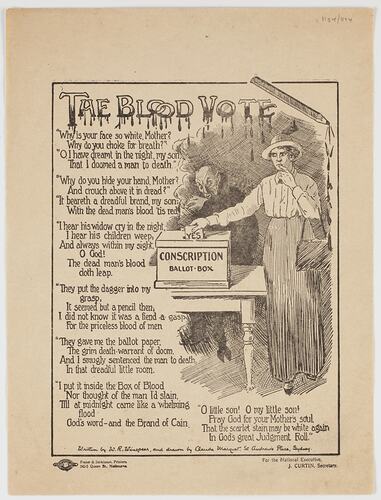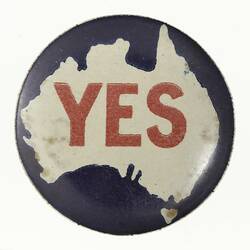Summary
Alternative Name(s): Broad sheet, Broadsheet, Flyer, Circular
Leaflet bearing a verse by W.R. Winspear and a cartoon by Claude Marquet, featuring an image a deeply worried woman casting a 'Yes' vote while Billy Hughes, Australia's labor prime minister and supporter of conscription, looks on gleefully. It was printed by Fraser & Jenkinson in Melbourne, 1917 and authorised by J. Curtin, Secretary for the 'National Executive'.
'The Blood Vote' was widely-published in papers such as The Australian Worker, The Westralian Worker and The Catholic Press. It was also posted directly into letterboxes. A campaign to counter its influence included letters of protest to newspapers and a pro-conscription version by Janet E. Stinson. One correspondent wrote: 'I had a letter left at my house this morning called "The Blood Vote", postage not paid. As I have an only son and two grandsons at the front, I think the above circular a downright insult to anyone having relations or friends at the front. I ask any reasonable man, is it humane or right to turn one's back on them and vote "No." The above document has emanated from rebels and traitors to their country. - Yours, etc., - W. BANNISTER. Mason street, Newport'. (Williamstown Chronicle, 28 Oct 1916)
When war was announced in 1914, support was high; vast numbers of men enlisted to serve in the Australian Imperial Forces (AIF). However stories of lost campaigns and war horrors, coupled with increasing casualty rates saw recruitment levels decline. By 1916 there was a shortage of men to fight overseas; Billy Hughes' Labor government proposed conscription as the solution to declining numbers of men. In a referendum held on 28 October 1916, Australians were asked: 'Are you in favour of the Government having, in this grave emergency, the same compulsory powers over citizens in regard to requiring their military service, for the term of this War, outside the Commonwealth, as it now has in regard to military service within the Commonwealth?' By a very narrow margin (51% against, 49 % for), the people of Australia rejected the referendum. After this failure, Hughes was expelled from the Labor Party. He promptly crossed the floor, along with about half of the parliamentary party, and became prime minister of a conservative Nationalist government.
The problem of declining numbers of men wishing to enlist did not go away. Consequently a second referendum was called. On 20 December 1917 the Australian public were asked: 'Are you in favour of the proposal of the Commonwealth Government for reinforcing the Commonwealth Forces overseas?' The answer was a resounding no. Australia was the only country (except South Africa) that did not vote to adopt conscription during World War I.
Physical Description
Small quarto broad sheet. Paper, illustrated on one side with an image of a deeply worried woman casting a 'Yes' vote while Billy Hughes, Australia's labor prime minister and supporter of conscription, looks on gleefully.
More Information
-
Collecting Areas
-
Acquisition Information
Purchase
-
Artist
-
Author
-
Authorised By
Right Honourable John Curtin, Melbourne, Victoria, Australia, 1917
-
Printer
-
Inscriptions
Printed on bottom of page: Fraser & Jenkinson, Printers./ 343-5 Queen Street, Melbourne; For the National Executive,/ J.CURTIN, Secretary.
-
Classification
-
Category
-
Discipline
-
Type of item
-
Overall Dimensions
190 mm (Width), 250 mm (Height)
-
References
The Dishonor Vote. (1917, December 13). Watchman (Sydney, NSW : 1902 - 1926), p. 5. Retrieved June 13, 2014, from [Link 1] CORRESPONDENCE. (1916, October 28). Williamstown Chronicle (Vic. : 1856 - 1954), p. 3. Retrieved June 13, 2014, from [Link 2]
-
Keywords

